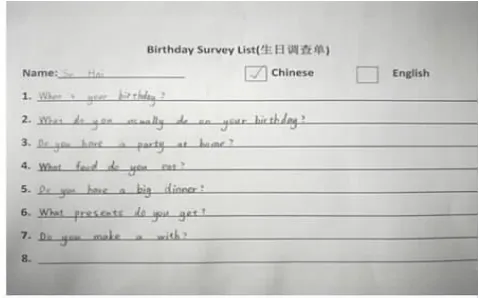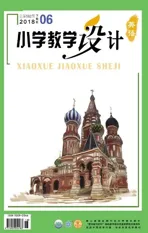基于“问题解决”的学习在Story Time 中的实践
2018-06-27陈霞
陈霞
基于“问题解决”的学习(Problem-based Learning,简称PBL)是指教材的知识点以问题的形式呈现在学生的面前,在教师的指导和帮助下,学生以小组的形式围绕某一实际问题主动探究一种学习策略(付晓丽,2017)。本文拟以笔者执教的译林新版《英语》五(下)U8 Birthdays的Story Time板块教学为例,阐述“对话类”文本的处理新思路,即以“完成调查”为实际问题,从“设计问卷、获取信息、分析结果、展示结果”四方面入手,在解决问题中获得语言能力,提高思维品质,获得文化体验,提升发现问题、分析问题和解决问题的能力。
一、分析学习难点,“生成”问题
(一)学习难点分析
1.日期的表达学生第一次接触,如the eighth of April,the eleventh of May.无论是语音还是结构,学生在朗读和理解上都存在一定的困难。
2.询问关于生日的问题,如When’s your birthday?What do you usually do on your birthday?...
3.比较分析苏海、苏阳和麦克生日的异同,进而发现中西方生日文化的异同,也是学生学习的难点。梳理生日活动,考查的是学生阅读文本获取信息的能力,而发现异同则需要学生观察、比较与分析,这是一种深度学习,学生需要去合作、探究,随后获得自己的发现。
(二)巧妙提出问题
基于以上学习难点,教师以“Miss Li wants to do a survey about Su Hai’s,Su Yang’s and Mike’s birthdays.What should she do step by step?”为本课探讨的“大问题”。随后教师引导学生思考具体如何做?学生接收到更具体的四项任务:“设计调查问卷(Design a questionnaire)”“获取问卷信息(Get information)”“分析调查发现(Find the differences)”以及“展示调查结果(Show the survey results)”。(见图1)

图1
【思考与分析】
基于“问题解决”的学习中“问题”是源动力,以解决问题为导向,学生在此学习活动中需要建构或重新建构自己的知识体系。问题解决的过程是对知识进行建构、巩固、深化和应用新知识的过程(付晓丽,2017)。“问题”应来源于生活或接近真实的问题。本文以“Miss Li调查学生的生日”为研究的“大问题”。对五年级学生来说,做调查并不陌生,然而之前的学习板块“Do a survey”形式简单,一般只需学生之间互相问答,获取信息。本文中的“调查”更接近真实生活中有一系列完整程序的实地调查,主要包括:“设计调查问卷”(提出关于生日的问题)“获取调查信息”(通过阅读文本,获取苏海、苏阳和麦克的生日信息)“分析调查结果”(仔细观察苏海、苏阳和麦克的生日信息,获得发现)“展示调查结果”(采用喜欢的方式展示调查发现)。教师巧妙地把学习内容融入若干个“小问题”中。基于问题情境,学生具有明确的学习动机和探究欲望。
二、自主合作探究,“解决”问题
(一)融提问于“设计调查问卷”中,主动建构知识
调查开始,教师引导学生思考:How can we design a questionnaire?
S1:We can ask questions about their birthdays.
T:Wonderful.And this time you should...
随后,明确解决该问题的步骤:
1.Choose one student you like to ask questions.
2.Work in group of four.Three ask questions and the other writes them down.
3.Share the questions.
学生提问(见图2,图3)

图2

图3
【思考与分析】
从学生的学习难点出发设计问题,体现了把课堂真正还给学生。学生们依据对苏海、苏阳和麦克个人情况的了解,设计调查问卷。问题是思维的“药引子”,它能使学生的求知欲由潜伏状态转入活跃状态,有力地调动学生思维的积极性和主动性,是开启学生思维器官的钥匙。学生提出了高于文本、真实又生活化的问题,主动建构语言和知识体系,进入了自主的学习状态。
(二)融释问于“获取问卷信息”中,分析解决难点
学生提出了很多关于苏海、苏阳和麦克生日的问题,第二项探究为:展开调查、获取信息。教师将学生引入问题情境:Su Hai,Su Yang and Mike are going to tell you about their birthdays.What should you do?
S1:We should write them down.
T:Bingo,and you can do like this.教师向学生展示了第二次自主学习的步骤,如下:
1.Listen to their dialogues for two times and each one chooses one or two questions to answer.
2.Talk about the information you get and help each other to learn.
3.Share the survey results.
以分享Su Hai的一组调查结果为例。
S1:Su Hai’s birthday is on the[ði:]eleventh of May.She usually has a big dinner with her parents and grandparents.She usually eats nood les.A fter that,she plays with Kitty the cat.
T:Su Hai’s birthday is on the[ði:]eleventh of May.Do you agree?
S2:Eleventh以元音发音开始,所以这里的the应该发[ði:],与in the afternoon,in the evening同理。
T:Boys and girls,do you agree with S2?
Ss:Yes.
T:Wonderful.But when is the eleventh of May?Here are two choices for you.
S1:I think it’s“5.11”because MAY is 5月.
T:You are really smart.Have you gotten all the information about Su Hai and Su Yang’s birthday?
S3:I guess Su Hai and Su Yang don’t usually have a party because Chinese peop le don’t usually have parties.I think the twins would like a cat because they like playing with Kitty the cat.
S4:I think the twins usually have the birthday party with their family because their family are having a big dinner together in the picture.
【思考与分析】
采用听的方式,拉近学生与被采访者的距离,仿佛彼此在面对面地进行调查,这样任务更显真实。获取问卷信息的过程中,学生碰到了学习困难,即日期的读法和理解。学生通过调动旧知,较为轻松地将其转化为新的知识体系。在解决文本未直接告知答案的题时,学生根据上下文分析、根据图片推测、根据自己的生活经验猜测,调查信息顺利获得,学生在这些问题面前自求自得,探索思悟。学生在解决与自身密切度相关的问题时,这种获得会长期在记忆中保存,并在头脑中保持一种开放的状态,可在今后的学习中进行重新加工或重新组合,“学习”真正发生。
(三)融对比于“分析调查结果”中,获得文化体验
在获取苏海、苏阳和麦克的生日信息后,教师给学生时间去梳理、去发现:Read Su Hai‘s and Mike’s birthday information carefully and try to compare.What can you find?
S1:Su Hai’s birthday is on the eleventh of May.Mike’s birthday is on the eighth of April.
T:Yes,so what can you find?
S2:Their birthdays are different.
T:Amazing.Their birthdays are on different days.What else can you find?
S2:Su Hai and Su Yang usually have a big dinner with her family.Mike usually has his birthday with his friends.
T:Does Mike only have his birthday with his friends?
S3:W ith his family,too.
T:So we can find Su Hai and Su Yang usually have a big dinner with her family.Mike usually has his birthday with his friends and family.
S4:They eat different food on their birthdays.Su Hai and Su Yang eat nood les.Mike eats the cake.
T:Does SuHai eat the cake,too?
S4:Yes.
T:Chinese peop le eat cakes on their birthdays and usual days as well.In fact,the ways Chinese and westerners celebrate birthday are getting similar.(见图4)

图4
【思考与分析】
温斯顿·布伦姆·伯格说过:“采取只知语言而不懂文化的教法,是培养语言流利的大傻瓜的最好办法。”学生在解决问题的过程中,独立思考,亲自参与知识的体系建构。通过苏海、苏阳和麦克的生日信息对比,学生大胆提出自己的发现,从浅层的生日信息对比,到深层的生日文化的提炼与总结,不仅发展了探究性思维,而且获得了文化体验,感受到了世界文化的逐步融合,也乐于接受这种文化差异,从而形成正确的价值观。
(四)融运用于“展示调查结果”中,创新汇报方式
在巩固运用环节,教师以“展示调查结果”的方式,提供学生多元展示学习成果的机会:You know a lot about Su Hai’s and Mike’s birthdays.It’s your turn to show the survey results.W ith your group,think of as many ways as you can to show.Can you tell me how?
S1:我打算根据苏海、苏阳和麦克的生日信息表,对比着汇报调查结果。比如:Su Hai’s birthday is on the eleventh of May.Mike’s birthday is on the eighth of April.
T:You want to be a reporter and compare their birthdays.A good way.
S2:I want to act.
T:Acting is a funny way.
S3:我想采用采访的形式。
T:That’s great.You can interview Su Hai,or Su Yang or Mike.And I am sure you can be a good interviewer.
【思考与分析】
《英语课程标准(2011年版)》指出,教学活动要“促进学生的认知能力、思维能力、想象力和创造力等综合发展”。本环节就“如何展示学习成果”引发了学生的思考,和传统的“朗读课文或表演课文”方式相比,学生创新了汇报方式:对比汇报调查结果、采访和表演故事,更加具有任务性和挑战性。这样,把学生学习知识的过程,变成了自主探究的“再发现”、“再创造”的过程,进而培养学生的问题意识和科学精神,构建创新素质。
三、评价总结反思,“拓展”问题
学生汇报之后,教师引导学生进行自我评价,总结学习效果和学习心得、获得学习结论和拓展新的学习问题。
T:The class will be over very soon.What do you learn from this lesson?
S1:I can read“the eleventh of May”and“the eighth of April”.
S2:I can ask a lot of questions about the birthday.
S3:I know the Chinese birthdays and western birthdays are different.
S4:我学会了合作,they help me.I can learn well.
T:Wonderful,I think you will be better at cooperating.Boys and girls,I am happy that you got a lot from this lesson.Do you still have any questions?
S1:What do other peop le do on their birthdays?
T:Do you want to know about the birthdays in the other countries?
S1:Yes.
T:Here’s a video named“Birthdays around the world”.You can watch it after class.You also can get more information on the internet and share with us next lesson.(见图5)

图5
【思考与分析】
评价自我学习、总结学习心得、获得学习结论作为课结束前的“整理动作”,可以帮助学生厘清思维路线,提高解决问题的能力。基于“问题解决”的学习始于问题却不能终于问题,对已解决的问题再探讨,拓展新的问题,使学习热情得以延伸至课后。学生在课后或个人或合作,查阅资料、共同探究,发起新一轮的学习。
基于“问题解决”的学习,学生始终为解决问题而努力,他们不断地思考、分析,力求发现问题的关键之所在,不断地加深对问题的理解,努力寻求多种解决办法。一个“大问题”里包含多个子问题,学生抽丝剥茧般攻破若干子问题,最终使整个问题获得解决(周久桃,2007)。从“生成”问题、“解决”问题到“拓展”问题,学生发展了语言能力,锤炼了思维品质,培养了文化品格,同时提升了发现问题、分析问题和解决问题的学习能力。
